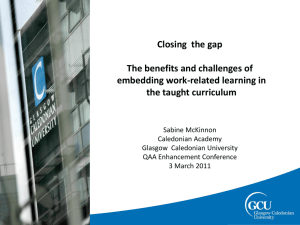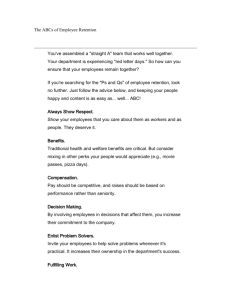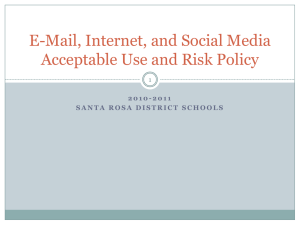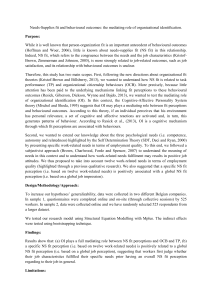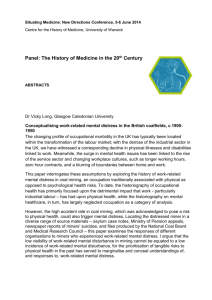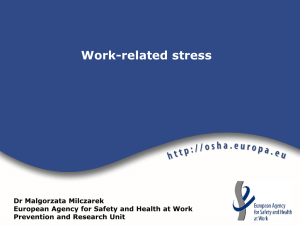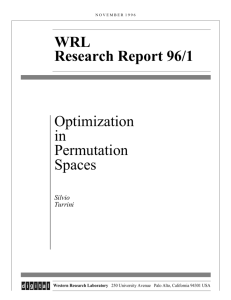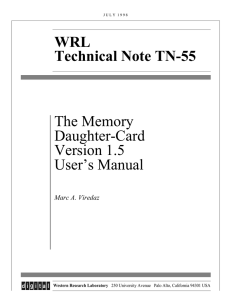Angeliki_Triantafyllaki_Paper
advertisement
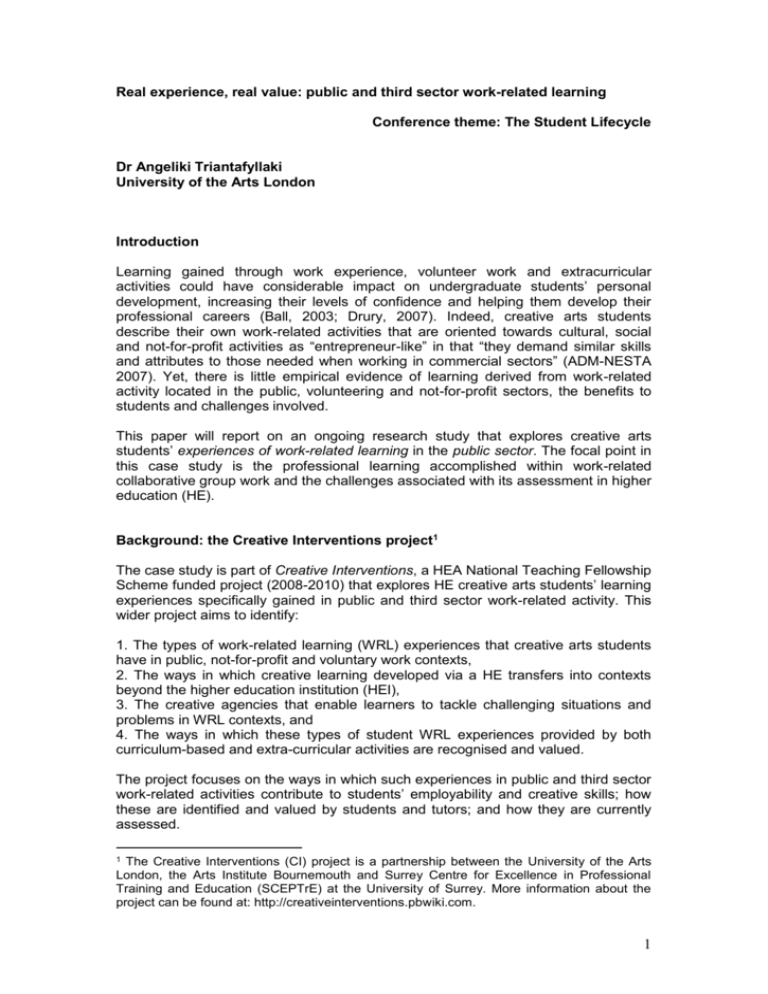
Real experience, real value: public and third sector work-related learning Conference theme: The Student Lifecycle Dr Angeliki Triantafyllaki University of the Arts London Introduction Learning gained through work experience, volunteer work and extracurricular activities could have considerable impact on undergraduate students’ personal development, increasing their levels of confidence and helping them develop their professional careers (Ball, 2003; Drury, 2007). Indeed, creative arts students describe their own work-related activities that are oriented towards cultural, social and not-for-profit activities as “entrepreneur-like” in that “they demand similar skills and attributes to those needed when working in commercial sectors” (ADM-NESTA 2007). Yet, there is little empirical evidence of learning derived from work-related activity located in the public, volunteering and not-for-profit sectors, the benefits to students and challenges involved. This paper will report on an ongoing research study that explores creative arts students’ experiences of work-related learning in the public sector. The focal point in this case study is the professional learning accomplished within work-related collaborative group work and the challenges associated with its assessment in higher education (HE). Background: the Creative Interventions project1 The case study is part of Creative Interventions, a HEA National Teaching Fellowship Scheme funded project (2008-2010) that explores HE creative arts students’ learning experiences specifically gained in public and third sector work-related activity. This wider project aims to identify: 1. The types of work-related learning (WRL) experiences that creative arts students have in public, not-for-profit and voluntary work contexts, 2. The ways in which creative learning developed via a HE transfers into contexts beyond the higher education institution (HEI), 3. The creative agencies that enable learners to tackle challenging situations and problems in WRL contexts, and 4. The ways in which these types of student WRL experiences provided by both curriculum-based and extra-curricular activities are recognised and valued. The project focuses on the ways in which such experiences in public and third sector work-related activities contribute to students’ employability and creative skills; how these are identified and valued by students and tutors; and how they are currently assessed. 1 The Creative Interventions (CI) project is a partnership between the University of the Arts London, the Arts Institute Bournemouth and Surrey Centre for Excellence in Professional Training and Education (SCEPTrE) at the University of Surrey. More information about the project can be found at: http://creativeinterventions.pbwiki.com. 1 Employing a mixed methods approach, the CI project aims: (1) to provide an overview of students’, tutors’ and employers’ views of WRL activities in the public and third sectors through online surveys (March-June 2009) and (2) more detailed, illustrative examples from creative arts disciplines through a series of in-depth institutional and disciplinary case studies (November 2008-March 2010). Work-related learning and collaborative activity Within creative arts HE, there has been a significant focus on work-based learning – the knowledge and skills acquired as students engage in professional activities as part of their course. Yet, unlike WRL, work-based learning normally does not support HE students learning about their own capabilities or detailed work aspirations (Moreland, 2005). The Quality and Curriculum Authority (QCA) defines WRL as, Planned activities that use the context of work to develop knowledge, skills and understanding useful for work, and this includes learning through the experience for work, learning about work and working practices, and learning the skills for work (2003). Yet, as Moreland (2005) argues, this definition does not seem to be concerned with the development of a graduate that better ‘fits’ the changing economic situation and evolving job markets in ways that assist the individual graduate to respond to societywide developments effectively and proposes another definition of WRL as, Involving students learning about themselves and the world of work in order to empower them to enter and succeed in the world of work and their wider lives. Incorporating a stronger element of student agency, self-efficacy and voice this definition of WRL promotes self-knowledge and moves towards self-managed learning that students can subsequently build upon (p.5). Within the rapid changes of the ‘knowledge society’ (Stehr, 1994), the key challenges that arise both in education and working life are about individuals, their communities and organizations continuously surpassing themselves, developing new competences, advancing their knowledge and understanding, as well as producing innovations and creating new knowledge (Paavola & Hakkarainen, 2005). When considering work-related activities as a site for learning through collaborative activity, it is perhaps not surprising that many of the examples readily sited are found mostly within the literature on workplace and organisational learning (Eraut, 2007a, 2007b; Nonaka & Takeuchi, 1995). Knowledge is now accessible from outside formal institutions and learning has become an explicit goal in activities not formally designated as education, especially work-related (Bentley, 2000). Correspondingly, educators are rapidly moving away from approaches that focus on developing individual skill levels and reproducing a canon of work to approaches where group work and the creation of original pieces and new forms of expression are encouraged (Rojas-Drummond, 2008). This approach explores both the nature and influence of interactions, relationships and cultures, which constitute and sustain such activity and the use of cultural tools and technologies, which mediate it (p.1). Within this framework, learning is regarded as collaborative meaning-making and knowledge construction rather than as knowledge acquisition (Eteläpelto & Lahti, 2008) and creativity is seen as a collective process that promotes professional 2 growth (Cremin, Burnard, & Craft, 2006). The Young Design Programme case study Overview The Sorrell Foundation’s2 Young Design Programme (YDP) is a 6-month annually run project (since 2005) whereby a group of school pupils act as ‘clients’ by commissioning a school design project, and their ‘consultants’ are students of design at university who, in turn, are mentored by professional designers and architects in industry. As a work-related activity encountered during creative arts higher education, the YDP is accessed by University tutors on behalf of their students and usually forms an assessed part of their course. The actual project involves groups of 4-6 creative arts students going into schools where a specific need relating to design has been identified, i.e. designing new school uniforms, new social spaces. A group of 10-15 pupils in participating schools are selected by their teachers and are challenged to identify a problem relating to design in their school that they would like solved. Creative arts student groups are then set a brief that they have to respond to by working together with and drawing on feedback from the pupils, the YDP organisers and their professional mentor. The aim of this case study was to investigate the ways in which collaborative workrelated activities with school pupils during a major school design project initiated new and creative spaces for learning for undergraduate creative arts students. Findings Three broad themes have been identified within student interview/focus group data collected during this case study that highlighted collaborative and creative approaches to learning: (1) learning relationships; (2) skills for learning; and (3) environments for learning. (1) Experiencing new relationships for learning Undergraduate student groups were often multi-disciplinary with members having had little or no contact with each other prior to their engagement with the YDP. What was for them a unique form of collaboration, students reported that the most valuable element of the Programme was operating outside the formal learning situations on their course much of which required little or no collaboration. “Being at Uni it was a lot about your work and your ideas. To work in a team and have such a big project and given the scope of the whole school and how do you focus that down and getting working ideas in quite a lot of detail…” Acknowledging individuals’ strengths and weaknesses and enabling individual voices to be heard as well as acknowledging one’s own responsibility within the groups, were key ingredients of a successful collaborative process. “You always pull out the strength of individuals rather than trying to fit them into whatever the task needs doing, because if they are not fit or if they are 2 The Sorrell Foundation is a charitable organisation that was set up in 1999 to inspire creativity in young people and improve the quality of life through design. 3 uncomfortable with doing it they won’t be able to do the best but if you give them a particular task that he or she is strong at you know the best comes out.” “There is a different pressure when you work within a team, a different dynamic … the more into the project you get, and the more familiar you are with each others’ roles the more responsibility you have to take on.” A key element of facilitating student-pupil collaborations and inspiring pupils was reported by students as being the creation of new codes of communication. “To get (school) children to listen to you, you have to talk in a very exciting way about something that you have to make them believe that you feel very passionately about.” Compromise and the negotiation of ‘control’ and ownership of ideas remained at the heart of the knowledge creating process. “In a team working experience you have to work with the other and it’s kind of like compromise and things like that, but you can be very creative with compromise. It means that your compromise is not lesser than others’ ideas; it could be a third idea that is even more wonderful.” Working together with pupils in order to ensure their views and ideas for their schools were fully incorporated in the final design concepts was valued by all participants. (2) Building skills for learning Encouraging self-knowledge and self-managed learning, the YDP incorporated an experiential element that was acknowledged by students when talking about the development of ‘know-how’. “There are things like that you can pick up on, but not – you can’t be taught how to communicate with someone … Those are just skills that you learn when – that’s what you learn when you go and do something in industry … (for example) working with others – I mean – even things like phone calls or emails that you have to do in a certain manner - you know (my tutor’s) not going to teach me how to write a letter to someone – you just learn with practice, and you know, the more emails you send and the more you receive, you learn how things work.” “It’s about adapting how you talk to different audiences. So you are addressing a client of 11-13 year olds and then you are addressing your professional mentors. And then you are going back and doing a presentation at Uni to your tutors. And we would tweak them according to the audience.” During the Programme, opportunities to take initiatives and greater responsibility for their own learning abounded. “At Uni if you don’t turn up then it’s your problem. But in the YDP if you don’t turn up in a meeting, you let everyone down and yourself down included. It was a bit more like it was your problem and you had to solve it, and the responsibility factor was a bit more. If you didn’t turn up it was a big deal, because everybody else was like ‘he let us down’.” 4 (3) Facilitating environments for learning There was a recurrent theme in the data of the dissonance between the more protected higher education context of learning and the opportunities afforded by the YDP for working on a ‘live’ project with a ‘real’ client. “(a) great experience working with a real client and having to come up with a design scheme that the client feels proud of.” “closer to a real job than just a college brief.” A key outcome of the programme highlighted by both students and their tutors was the development of student voice, in that it provided students with a space where their ideas would be welcomed as well as challenged. “At Uni I was protective about my work and a little secretive at times. But on the YDP it felt like an environment were you can talk about your ideas. I guess it’s about being part of a team as well. You have an equal share of responsibility for the ideas. You are not putting yourself completely out there.” Importantly, the Programme provided students with a space where their ideas would be welcomed as well as challenged and opened up for students alternative pathways into employment after graduation, allowing for a wider range of identities to emerge. “It gave me much more confidence that whatever course I am on doesn’t have to be the final thing. I can juggle things a bit more and be in the creative industries somewhere and that course is not the label I am going to have for the rest of my days. So it was a bit like there are so many sets of skills that we have to work with … So it opened up a bigger perspective on things.” “It definitely did help in resolving in my mind as a practitioner what I liked and what I didn’t like and where my stand was in terms of my architectural self, so it did help define my personality as a practitioner.” As these data suggest, students learnt about different ways of creating and learning in collaboration with diverse groups of people and in a range of physical spaces. Their participation in a work-related collaborative activity that comprised of settings and processes quite different to those encountered during their course encouraged students to build upon and expand their existing knowledge and skills. Finally, one of the paradoxes of HE study but most obviously within the creative (and performing) arts, is the necessity to arrive at a numerical figure which represents, for example, a live performance, as well as to ascertain individual contributions within a group project (Bryan, 2004:56). Students reported that the challenges of assessment related to a focus on outcomes and product rather than processes: “I found it really satisfying to get good feedback from the kids … you know having good client feedback was more valuable for me than an assessment from my tutors – probably because they just didn’t know what it was that I was doing … they would not have known anything about it.” “It wasn’t really formally assessed it was more like ticking the box … but it’s 5 far better an assessment of the work having feedback from the clients on the whole package and the whole experience.” For many students, the assessment of collaborative group work in HEIs seemed at odds with the kind of risk-taking and identity work promoted during the Programme as reported above. Attempts are now being made to involve students in their own assessment processes, with a student group currently undertaking the Programme also being assessed on a Personal Development Planning (PDP) assignment that asks them to reflect (both in visual and written form) on their experience of working collaboratively in relation to how this influenced the actual work produced. Such endeavours, often facilitated by individual tutors, represent a more holistic approach to assessment. Discussion / Conclusion From these main themes that cut across the data there is evidence that students forged close connections between (1) the significance of new roles and learning relationships; (2) the impact of diverse contexts for learning; and (3) the knowledge that they co-constructed within their groups and with the school pupils. New roles and relationships for learning: The case study findings demonstrated strongly the importance of educational practices providing greater experience of the ways in which knowledge is used in society by challenging participants to take on unfamiliar roles and responsibilities. Undergraduate students’ roles continuously shifted from being ‘experts’ in their own disciplinary field within their multidisciplinary groups; ‘apprentices’ within mentor-student relationships; ‘designers’ for schools and pupils; and ‘representatives’ for their University when presenting their work to other parties, such as the school or parents. During collaborative work-related activities participants needed and depended on each other and in so doing adopted a mutually adaptive stance to learning from which each was able to engage in what Schön (1983) calls ‘reflection-in-action’ and share each others’ learning concerns whilst inspiring confidence and commitment. New contexts for learning: In the HE context a key question arises as to what sort of informal learning works best in practice, and what kinds of partnerships are likely to improve the undergraduate learning experience and encourage the integration of students’ conceptual or formal knowledge with their understandings and expectations of non-formal and informal contexts. Aligning employability agendas (Ball, 2003) with calls for the social and moral responsibility of education could be a way forward. In this paper, undergraduate creative arts students were offered a kind of ‘critical vocationalism’ (Usher et al, 1997) in which learning took place in a climate of social responsibility as opposed to more instrumental models of vocational learning (Butcher, 2008). If the kinds of informal learning developed within work-related activities are to contribute to formal educational aims and agendas, it is essential that more attention is afforded to the social, cultural, and physical contexts in which they are promoted. Co-constructing knowledge: A key feature of the findings was the construction of new knowledge within unfamiliar educational practices and contexts. The findings revealed high levels of rigorous and deep learning as creative arts students adjusted their language and practice to take into account pupils’ views and ideas; responded to and reflected on the physical spaces they were called upon to (re-) design; took responsibility for their own learning and showed commitment to the task; and developed the ‘know how’ of processes and practices of working with others in 6 unfamiliar conditions. Such deep learning seemed at odds with the outcome-based assessment of collaborative group activity as reported by students. With regards to this final point, Smith et al (2007) discuss employability in HE in terms of transferable skills, through which engaged learners can relate (or ‘transfer’) academic understanding to work-based experiences. They argue this depends upon reflection-on-action, in which tacit knowledge is made explicit as part of an experience encouraging reflection and deep learning. If education systems should strive for three ends in enhancing youths’ knowledge-building capacities and, consequently, lifelong learning: autonomy, responsibility and creativity (Bentley, 2000) and if creativity involves among others the ‘capacity to apply one’s knowledge in ways which extend and develop it’ (p.357), it follows that transforming current educational practices and learning cultures could very well depend on: Merging individual potential and competencies with collaborative practices in non-formal contexts as important sites for creativity Finding new ways to value and assess both creative processes and outcomes, and ultimately Shifting our understanding of student identity from that of ‘student’ to that of ‘creator’ of knowledge. References ADM & NESTA (2007) Creating Entrepreneurship: Entrepreneurship Education for the Creative Industries. ADM-HEA and NESTA. Ball, L. (2003) Future Directions for Employability Research in the Creative Industries. Art, Design and Communication – Learning and Teaching Support Network (ADC-LTSN). Bentley, T. (2000) ‘Learning beyond the classroom’. Educational Management Administration and Leadership, 28(3), 353-364. Bryan, C. (2004) ‘Assessing the creative work of groups’. In: D. Miell & K. Littleton (eds) Collaborative Creativity: Contemporary Perspectives. London: Free Association Books. Butcher, J. (2008) Aspiration raising alongside undergraduate learning: the Sorrell Young Design Programme as an authentic partnership. Paper presented at NALN 2008 Workshop 1b The Young Design Programme Cremin, T., Burnard, P. & Craft, A. (2006) ‘Pedagogy and possibility thinking in the early years’. International Journal of Thinking Skills and Creativity, 1(2), 108-119. Drury, R. (2007) Learning Beyond the Curriculum; A Pilot Inquiry into how Students' Extra-Curricular Activities are Valued in the Curriculum at the University of the Arts London. Centre for Learning & Teaching in Art & Design. Eraut, M. (2007a) 'Early career learning at work and its implications for universities'. Student Learning and University Teaching, BJEP Monograph Series, 11(4), 113-133. Eraut, M. (2007b) 'Learning from other people in the workplace'. Oxford Review of Education, 33(4), 403-422. Eteläpelto, A. & Lahti, J. (2008) ‘The resources and obstacles of creative 7 collaboration in a long-term learning community’. Thinking Skills and Creativity, 3, 226-240. Moreland, N. (2005) Work-Related Learning in Higher Education. Learning and Employability Series 2, no.1: The Higher Education Academy. Available at: http://www.palatine.ac.uk/files/emp/1273.pdf. Nonaka, I. & Takeuchi, H. (1995) The Knowledge-Creating Company: How Japanese Companies Create the Dynamics of Innovation. New York: Oxford University Press. Paavola, S. & Hakkarainen, K. (2005) ‘The knowledge creation metaphor: an emergent epistemological approach to learning’. Science and Education, 14, 535557. Schön, D. A. (1983) The Reflective Practitioner: How Professionals Think in Action. London: Temple Smith. Smith, K., Clegg, S., Lawrence, E. & Todd, M. (2007) ‘The challenges of reflection: students learning from work placements’. Innovations in Education and Teaching International, 44(2). Stehr, N. (1994) Knowledge Societies. London: Sage. QCA (2003) Work-Related Learning for All at Key Stage 4: Guidance for Implementing the Statutory Requirement from 2004. London: Quality and Curriculum Authority. Triantafyllaki, A. & Smith, C. (2009) “‘It’s almost like a medal that you wear afterwards’: undergraduate students’ experiences of work-related learning in the public and third sectors”. Assessment, Learning and Teaching Journal, Spring issue. Usher, R., Bryant, I. & Johnston, R. (1997) (eds) ‘Adult learning for citizenship’. In: Adult Education and the Postmodern Challenge. London: Routledge. 8
